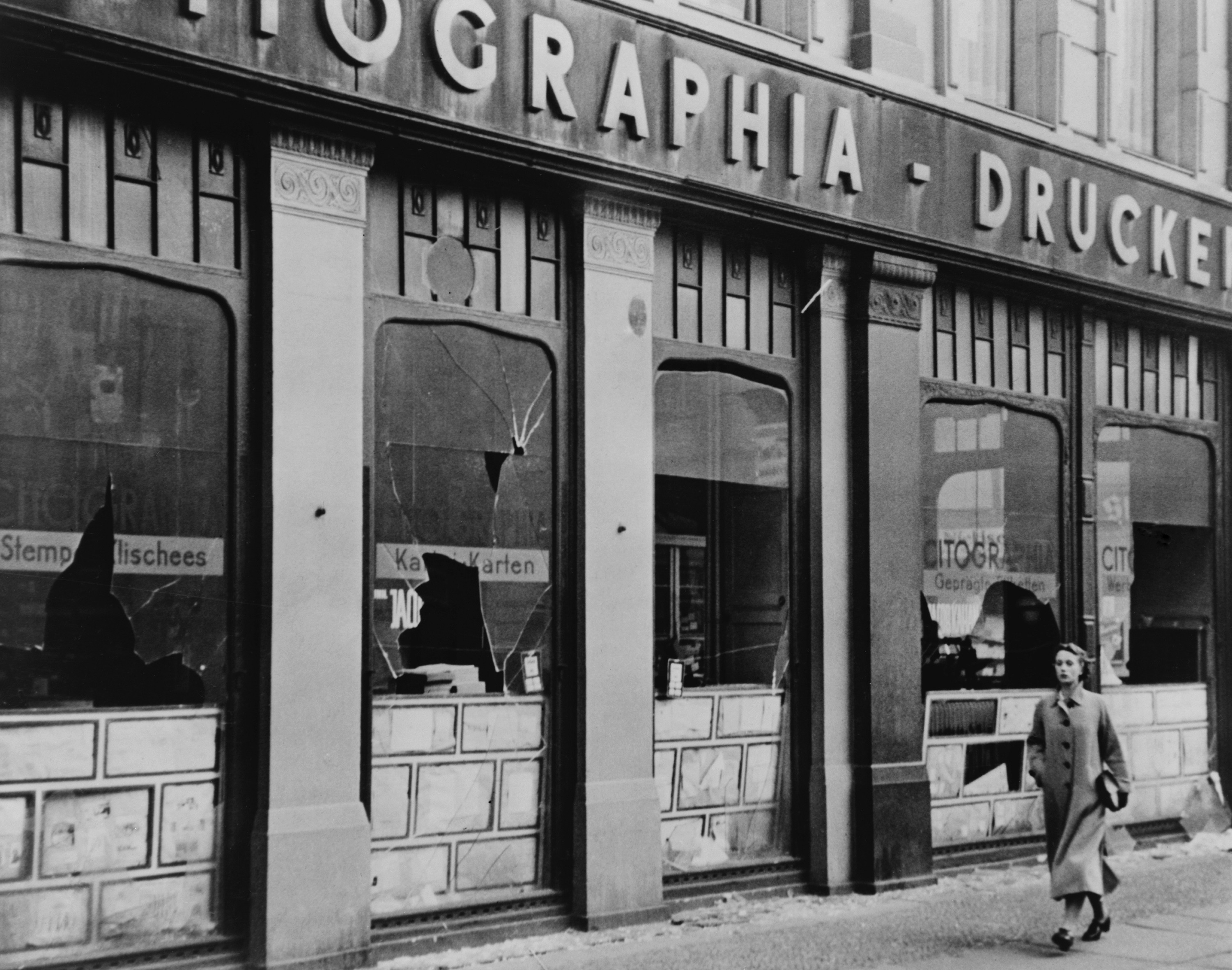

Eighty years ago today, November 9, 1938, an order was given by Nazi German authorities to terrorize and arrest German Jewish citizens, resulting in tens of thousands of people being sent to concentration camps. Kristallnacht, or the Night of Broken Glass, marked a violent escalation against Jewish people. This escalation of violence was a continuation of anti-Semitic policies instituted in 1933, but was also part of a long history of discrimination against Jewish people.
In the October issue of The American Historical Review, the most prominent professional history journal in the United States, historians have taken on the task of understanding “the vexed history of anti-Semitism.”[1] In a “roundtable discussion,” historians debate the origins of the term itself, which only appeared in the late nineteenth century. They discuss alternative terminologies, such as Judeophobia, which Jewish historian Jonathan Judaken “defends as an overarching category for the field.”[2] In his writing, Judaken pushes to understand and differentiate ancient Judeophobia and medieval anti-Judaism, Nazi anti-Semitism, and contemporary anti-Zionism. Judaken pushes to both understand continuities and changes. Searching to understand the origin of the word “anti-Semitism,” historian David Feldman locates its usage in the 1870s—after political and civil equality for Jews is achieved in Germany in 1871.[3]
As Feldman points out, the prominent British-Jewish journalist, editor and activist Lucien Wolf wrote of anti-Semitism in an entry commissioned for the Encyclopedia Britannica’s eleventh edition, which came out in 1910. In that entry, Wolf writes, “In the political struggles of the concluding quarter of the nineteenth century an important part was played by a religious, political and social agitation against the Jews, known as ‘Anti-Semitism.’ The origins of the remarkable movement already threaten to become obscured by legend. The Jews contend that anti-Semitism is a mere atavistic revival of the Jew-hatred of the Middle Ages.”[4] In this way, Wolf describes anti-Semitism as being felt as part of a continual form of oppression by Jews.
However, for xenophobes of the period, Wolf writes, “The extreme section of the anti-Semites, who have given the movement its quasi-scientific name, declare that it is a racial struggle—an incident of the eternal conflict between Europe and Asia—and that the anti-Semites are engaged in an effort to prevent what is called the Aryan race from being subjugated by a Semitic immigration, and to save Aryan ideals from being modified by an alien and demoralizing oriental Anschauung.”[5] Wolf’s analysis from over a hundred years ago gives us insight not just into anti-Semitism, but also to the ways that a fear of “the other” operates—one that Jewish people have endured at many points in their history. Not just in the Holocaust, but also during various pressure points in history, including the expulsion of Jews from Spain in 1492, which was also extended to Muslims, who for centuries were characterized as “invaders” despite seven centuries in the Iberian Peninsula. Jews had been in the peninsula since Roman times.
Moreover, Wolf identifies a particularly modern form of Judeophobia, one that is informed by a fear of immigration that is seen by anti-Semites as a challenge to what they see as culturally European, or, more broadly, the West. Through Wolf, we can better understand our own contemporary moment. In the aftermath of the Holocaust, we have seen new expansions and definitions of equality and human rights, as well as laws written to provide political and civil equality for groups that have been oppressed or marginalized historically — including women, ethnic and religious minorities, LBGTQ people, the poor, people of color, and people with disabilities. Today, there is a fear emerging amongst dominant groups in Europe and the Americas of what exactly that equality means. Anxiety has arisen in those who have been in a privileged place in society that their power will be diminished. At the extremes, the radical right fears supposed “angry mobs” will come after them in revenge for millennia of oppression. Moreover, they are scared that immigration will challenge their way of being—make them into something “alien.” We see echoes of this language when the radical right calls those seeking refuge “invaders” and “aliens.” Through this language, on the extremes, white nationalists decry a “white genocide,” a gross and inverted use of the word genocide, to describe what they see as a threat to their own place in the world.
As Wolf writes, “Anti-Semitism is… exclusively a question of European politics, and its origin is to be found, not in the long struggle between Europe and Asia, or between the Church and the Synagogue, which filled so much of ancient and medieval history, but in the social conditions resulting from the emancipation of the Jews in the middle of the 19th century.”[6] As peoples who have been marginalized have found emancipation, we must continue to protect and fight for those hard-fought civil and political rights. On this eightieth anniversary of Kristallnacht, it is our duty not to only stand up against anti-Semitism, but all sorts of oppression. As Martin Niemöller indicates in his famous poem, all oppression is connected; we must speak out now, before they come for us.
Louie Dean Valencia-García is an Assistant Professor of Digital History at Texas State University and a Senior Fellow at the Centre for Analysis of the Radical Right. He has taught in the Faculty of Arts and Sciences at Harvard University, and serves on the Research Editorial Committee for EuropeNow. He is the author of Antiauthoritarian Youth Culture in Francoist Spain: Clashing with Fascism. He has held fellowships from the Andrew W. Mellon Foundation, the United States Library of Congress, the Spanish Ministry of Education, Culture and Sport, and Santander Universities, amongst others.
Photo: Windows of a Jewish owned printing business smashed during Kristallnacht, Berlin. November 9-10, 1938 | Shutterstock
References:
[1] “In This Issue,” The American Historical Review 123, no. 4 (October 1, 2018): xi.
[2] Jonathan Judaken, “Introduction,” The American Historical Review 123, no. 4 (October 1, 2018): 1122.
[3] David Feldman, “Toward a History of the Term ‘Anti-Semitism,’” The American Historical Review 123, no. 4 (October 1, 2018): 1140.
[4] Lucien Wolf, “Anti-Semitism,” Encyclopaedia Britannica (Cambridge: Encyclopaedia Britannica, 1910), 134–46.
[5] Ibid.
[6] Ibid.
Published on November 9, 2018.




